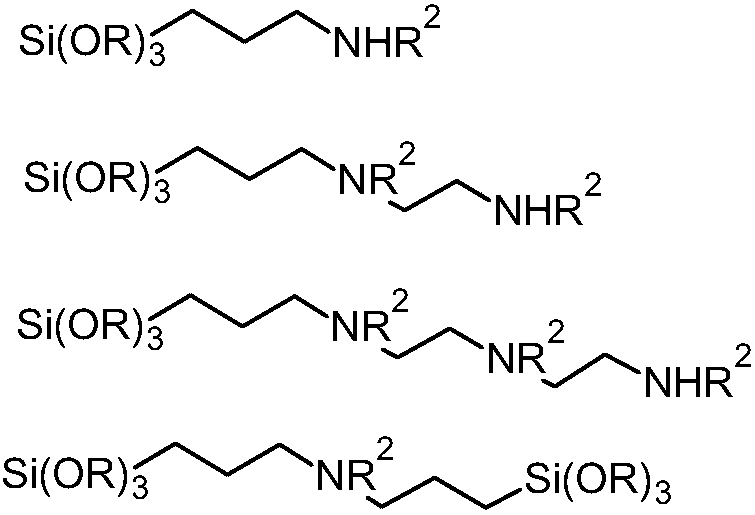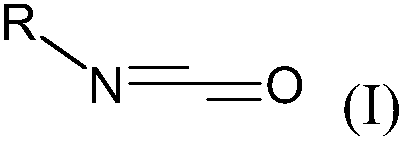Method for applying, to an inorganic surface, a PVC composition having improved adhesion to surfaces
A composition and inorganic technology, applied in the sealing of engines, chemical instruments and methods, adhesives, etc.
- Summary
- Abstract
- Description
- Claims
- Application Information
AI Technical Summary
Problems solved by technology
Method used
Image
Examples
Embodiment
[0179] Description of the peel test (to determine surface adhesion)
[0180] The peel test measures the force (N) required to separate the PVC layer from the substrate (glass or metal plate, preferably steel) supporting the surface.
[0181] The PVC composition is deposited on a surface (glass or metal plate, preferably steel) with a size of 50x10 cm. The assembly is placed in a gradient oven reaching a temperature of 200°C to overmold the surface (glass or sheet metal, preferably steel) with PVC material.
[0182] Peel tests were performed using a LLOYD Instrument detector (Ametek Company). The obtained samples are placed in the tensile testing apparatus, the surface is fixed.
[0183] The test conditions are as follows:
[0184] Crosshead speed: 100mm / mi,
[0185] Maximum crosshead displacement: 80mm
[0186] If the peel force is above 40N, the rupture is said to be cohesive and transfers the excellent adhesion of the composition to the substrate.
Embodiment 1
[0201] Example 1 - PVC composition of the invention
[0202] The PVC composition was prepared using a PVC base (Kwert 65) containing 29% by weight of T8-10 plasticizer, 1.5% by weight of stabilizer (Ca / Zn), 0.5% by weight of costabilizer, 2.9% by weight of 3-(Aminopropyl)triethoxysilane and 1.5% by weight of bis[2-[(2-aminoethyl)amino]ethoxy][2-[(2-aminoethyl)amino]ethoxy base-O](prop-2-oxyl) titanate.
[0203] The glass surface was treated with methyl ethyl ketone at ambient temperature before heating in an oven to 200°C.
[0204] The PVC composition was applied by extrusion (Escuyer 40) under the following conditions:
[0205] - a die temperature of 170°C, with a temperature profile of 160 to 180°C; and
[0206] - The extrusion rate is 35 rpm.
[0207] The adhesion strength measured by performing a peel test on a glass surface is higher than 40N. The measured thermal stability (measured at 200°C) was 30 minutes.
Embodiment 2
[0208] Example 2 - PVC composition of the invention
[0209] The PVC composition was prepared using a PVC base (Kwert 65) containing 29% by weight of T8-10 plasticizer, 1.5% by weight of stabilizer (Ca / Zn), 0.5% by weight of costabilizer, 2.9% by weight of 3-(aminopropyl)triethoxysilane protected by tert-butoxycarbonyl functional group, and 1.5% by weight of bis[2-[(2-aminoethyl)amino]ethoxy][2-[(2 -Aminoethyl)amino]ethoxy-O](propan-2-oxy)titanate.
[0210] The glass surface was treated with methyl ethyl ketone at ambient temperature before heating in an oven to 200°C.
[0211] The PVC composition was applied by extrusion (Escuyer 40) under the following conditions:
[0212] - a die temperature of 170°C, with a temperature profile of 160 to 180°C; and
[0213] - The extrusion rate is 35 rpm.
[0214] On glass surfaces, the adhesion strength measured by performing a peel test is higher than 40N. The measured thermal stability (at 200°C) was 106 minutes.
PUM
| Property | Measurement | Unit |
|---|---|---|
| thickness | aaaaa | aaaaa |
Abstract
Description
Claims
Application Information
 Login to View More
Login to View More - R&D Engineer
- R&D Manager
- IP Professional
- Industry Leading Data Capabilities
- Powerful AI technology
- Patent DNA Extraction
Browse by: Latest US Patents, China's latest patents, Technical Efficacy Thesaurus, Application Domain, Technology Topic, Popular Technical Reports.
© 2024 PatSnap. All rights reserved.Legal|Privacy policy|Modern Slavery Act Transparency Statement|Sitemap|About US| Contact US: help@patsnap.com










